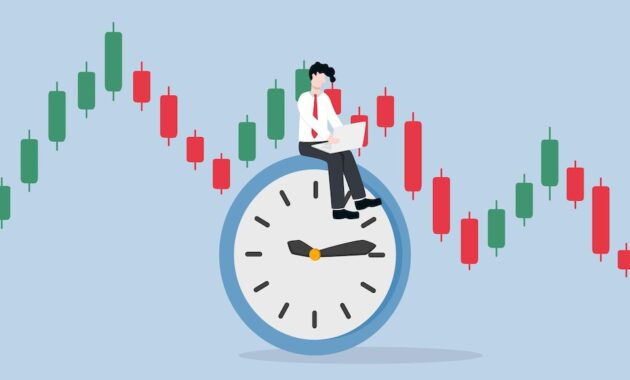Timing is crucial in investing. Many want to purchase cheap and sell high, but only some can. Market timing tactics help investors make educated asset purchases and sales. Fundamental, technical, and sentiment analysis are used in these techniques.
Fundamental analysis examines financial and economic issues that affect asset prices, whereas technical analysis uses price charts and patterns. In contrast, sentiment analysis evaluates market participants’ aggregate emotions. These tools help investors navigate the ever-changing financial world with confidence and accuracy.
Fundamental Analysis
What Is Fundamental Analysis?
Fundamental research is essential to market timing and assessing investment possibilities. This method goes beyond price patterns and charts to examine the underlying elements that affect an asset’s intrinsic value.
Fundamental analysis evaluates an asset’s value based on company finances or national economies. This requires studying financial accounts, economic statistics, industry trends, and company-specific data methodically. Fundamental analysts determine if an asset is overpriced or undervalued to help them decide whether to purchase or sell.
Using Fundamental Analysis For Market Timing
Fundamental research guides market timing. investors utilize this method to find hidden dangers and opportunities. Important market timing indicators:
- Solid profits Reports: A reliable firm with consistent profits is a good purchase. Conversely, falling profits may indicate selling.
- Revenue Growth: A plateau or drop in revenue growth may indicate a sell signal.
- Profit Margins: Rising margins suggest good management while falling margins signal difficulty.
- Economic metrics: GDP growth and inflation rates may influence market timing. Intense financial circumstances may drive purchasing, whereas downturns may prompt selling.
Fundamental research helps investors make sensible decisions in turbulent markets. It delivers market timing data and insights for long-term success.
Technical Analysis
What Is Technical Analysis?
Technical analysis uses historical price data, charts, and trade volumes to time the market. It assumes that the market price of an item already includes all relevant information. By studying price patterns and trends, investors may predict future price changes.
Using Technical Analysis For Market Timing
Technical analysis gives investors market-timing tools. how technical analysis works:
- Price charts: Analysts analyse line, bar, and candlestick price charts. Historical price charts help investors see trends.
- Technical indicators: Many technical indicators evaluate buy and sell signals. Moving averages, relative strength, and MACD are standard indicators.
- Pattern Recognition: Technical analysts see head-and-shoulders, double tops, and flags in price charts. These patterns may predict price changes.
Technical analysis is useful for short-term traders who capitalise on market variations. Its scientific and data-driven market timing strategy helps investors make confident selections.
Sentiment Analysis
What Is Sentiment Analysis?
Market or investor sentiment study measures market participants’ emotions and attitudes. It recognises that investor emotion may significantly affect market dynamics. Sentiment analysis determines if market sentiment is optimistic or pessimistic.
Using Sentiment Analysis For Market Timing
A significant tool in market timing tactics is sentiment analysis. how it works:
- Market Sentiment: Indicators and tools measure market sentiment. The CBOE Volatility Index (VIX), known as the “fear gauge,” predicts market volatility. High VIX values may indicate market nervousness and imply a sale. However, low VIX levels may tell complacency, offering a purchase opportunity.
- Contrarian Approach: The contrarian perspective underpins sentiment analysis. This method implies that excessive bullish sentiment may signify an overheated market and a probable sell-off. Extreme pessimistic emotion may indicate a market bottom, offering a buying opportunity.
Investors may use sentiment indicators to understand market sentiment and investor behaviour to time the market. Investors may avoid emotional mistakes and make data-driven decisions via sentiment analysis.
Combining Approaches
Market timing may be improved in several ways. A more thorough market timing method combines fundamental, technical, and sentiment research. By merging various analytical tools, investors want to overcome individual technique constraints and acquire a more holistic market perspective.
1. Broad Perspective:
Each market study method provides distinct information. Technical analysis analyses price movements, sentiment analysis evaluates investor sentiment, and fundamental analysis evaluates company finances and the economy. Combining these gives investors a more comprehensive view.
2. Confirmation And Validation:
Another analytical method may confirm a buy or sell indication. Technical indications demonstrating significant rising price patterns may support a fundamental review of a company’s financial health.
3. Risk Mitigation:
Differentiating analysis helps control risks. All ways leading to the same result boost market timing confidence. If one method proposes an alternative course, the choice is reconsidered.
4. Adaptability:
Market circumstances fluctuate; therefore, one analytical method may not work. Combining strategies helps investors react to market changes. Amid economic downturns, fundamental research may be more important than sentiment analysis amid volatility.
Common Pitfalls And Risks
Market timing tactics may be lucrative, but they also have risks. Investors must be aware of these dangers and be cautious during market timing. Here are some market timing mistakes and chances:
- Overtrading: Overtrading is a classic trap to slip into when trying to time the market. Overactive investors may purchase and sell assets in reaction to short-term market volatility. High transaction costs, taxes, and lower profits might occur.
- Decisions Made Emotionally: Making decisions based on emotions is a considerable risk. Investors may purchase or sell impulsively due to fear or greed. Emotions may impede market timing discipline.
- Timing Errors: Market predictions are difficult. Investors may time market entries and exits incorrectly. These mistakes may cost a lot.
- Missed Opportunities: Market timing requires short-term projections. Investors with inconsistent timing may miss long-term growth possibilities. Markets rise over time, and taking advantage of significant growth may be expensive.
- Lack of diversity: Market timing tactics may need more variety. Investors may focus on a few items, thinking they have ideal timing. Lack of diversity raises risk.
- Unexpected Events: Economic crises and geopolitical shocks may derail even the most excellent market timing methods. These unpredictable occurrences might cause market volatility.
- Timing costs: Transaction expenses, taxes, and fees reduce profits from frequent trading. Investments must account for these expenses while timing the market.
Market timing could be better and may not work. Investors must be cautious, monitor risk, and assess risk tolerance. They should also know the risks and be disciplined. Understanding the markets, analysis, and investing goals is essential for market timing.
Conclusion
Investors benefit from fundamental, technical, and sentiment analysis-based market timing tactics. Fundamental analysis determines asset value, technical study examines price patterns, and sentiment analysis measures market sentiment. Investors may maximise their chances of success in complicated financial markets by carefully integrating these tactics to make educated buying and selling choices.

